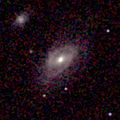| NGC 1241 | |
|---|---|
 NGC 1241 by Hubble Space Telescope | |
| Observation data (J2000 epoch) | |
| Constellation | Eridanus |
| Right ascension | 03h 11m 14.6s [1] |
| Declination | −08° 55′ 20″ [1] |
| Redshift | 0.016652 ± 0.000020 [1] |
| Heliocentric radial velocity | 4,052 ± 4 km/s [1] |
| Distance | 144 ± 36 Mly (44.1 ± 11 Mpc) [1] |
| Apparent magnitude (V) | 12.2 [2] |
| Characteristics | |
| Type | SB(rs)b [1] |
| Apparent size (V) | 3.3′ × 2.2′ |
| Notable features | Seyfert galaxy |
| Other designations | |
| ARP 304, MCG -02-09-011, VV 334a, Holmberg 068A, PGC 11887 [1] | |
NGC 1241 is a spiral galaxy located in the constellation Eridanus. It is located at a distance of circa 150 million light years from Earth, which, given its apparent dimensions, means that NGC 1241 is about 140,000 light years across. It was discovered by William Herschel on January 10, 1785. [3] It is classified as a Seyfert galaxy.
Contents
NGC 1241 interacts with its smaller companion NGC 1242, forming a pair collectively known in the Atlas of Peculiar Galaxies as Arp 304.



